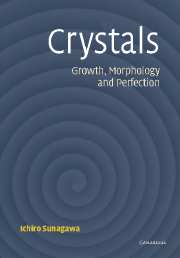Book contents
- Frontmatter
- Contents
- Foreword to the English translation
- Preface
- Part I Fundamental concepts
- 1 Introduction
- 2 Crystal forms
- 3 Crystal growth
- 4 Factors determining the morphology of polyhedral crystals
- 5 Surface microtopography of crystal faces
- 6 Perfection and homogeneity of single crystals
- 7 Regular intergrowth of crystals
- 8 Forms and textures of polycrystalline aggregates
- Part II Application to complicated and complex systems (case studies)
- Appendixes
- Materials index
- Subject index
3 - Crystal growth
from Part I - Fundamental concepts
Published online by Cambridge University Press: 31 October 2009
- Frontmatter
- Contents
- Foreword to the English translation
- Preface
- Part I Fundamental concepts
- 1 Introduction
- 2 Crystal forms
- 3 Crystal growth
- 4 Factors determining the morphology of polyhedral crystals
- 5 Surface microtopography of crystal faces
- 6 Perfection and homogeneity of single crystals
- 7 Regular intergrowth of crystals
- 8 Forms and textures of polycrystalline aggregates
- Part II Application to complicated and complex systems (case studies)
- Appendixes
- Materials index
- Subject index
Summary
It is only when a driving force causes a system to depart from its equilibrium condition that a nucleus of a crystal is formed and growth begins. Solid, melt, solution, and vapor phases may be distinguished as ambient phases in which crystals can grow. These can be systematically classified depending on whether they are condensed or dilute phases, and whether solute-solvent interaction is involved or not. In a driving force, heat and mass transfers are coupled, but the degree of their respective contributions depends on the type of ambient phase involved. The interface between the crystal and the ambient phase is the unique place where growth or dissolution takes place.
We may consider the interface problem by classifying its structure into atomically rough and smooth interfaces. An adhesive-type growth mechanism is expected for an atomically rough interface, whereas on atomically smooth interfaces crystals grow either by two-dimensional nucleation and layer growth or by a spiral growth mechanism. Based on the above analyses, mutual relations among polyhedral, hopper, and dendritic morphologies can be systematized.
Equilibrium thermodynamics versus kinetic thermodynamics
Crystal growth is the process of the birth and development of a solid phase with a regular structure out of a disordered and irregular state, and thus it can be regarded as a first-order phase transition.
The science dealing with phase transitions is thermodynamics. Using thermodynamics, we may discuss which phase will eventually be formed when a material (of composition c and phase p) is maintained under the same conditions for an infinite time, and the phase reaches the minimum energy state (equilibrium state) under given thermodynamic conditions (temperature and pressure).
- Type
- Chapter
- Information
- CrystalsGrowth, Morphology, & Perfection, pp. 20 - 59Publisher: Cambridge University PressPrint publication year: 2005
- 4
- Cited by

